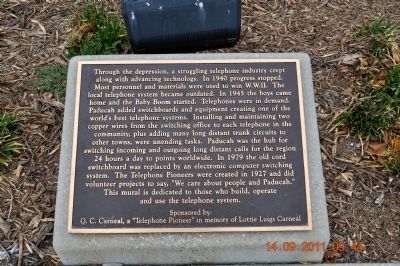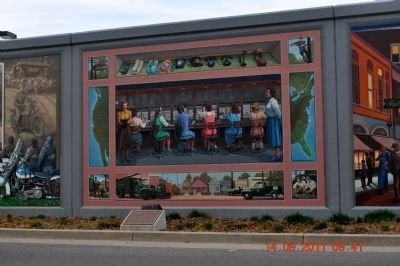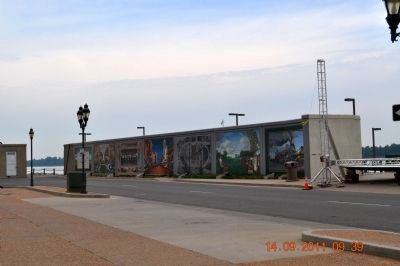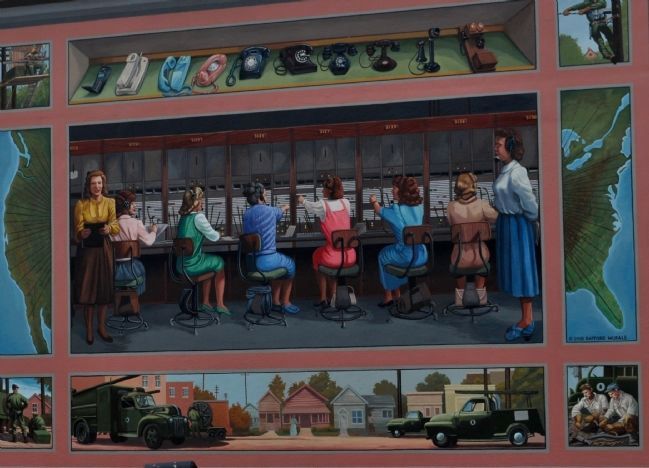Paducah in McCracken County, Kentucky — The American South (East South Central)
The Telephone System
Erected by Sponsored by: G.C Carneal, a "Telephone Pioneer" in memory of Lottie Luigs Carneal.
Topics. This historical marker is listed in this topic list: Communications. A significant historical year for this entry is 1940.
Location. 37° 5.352′ N, 88° 35.685′ W. Marker is in Paducah , Kentucky, in McCracken County. Marker is at the intersection of North Water Street and Jefferson Street, on the right when traveling north on North Water Street. Touch for map. Marker is in this post office area: Paducah KY 42001, United States of America. Touch for directions.
Other nearby markers. At least 8 other markers are within walking distance of this marker. Flanking the Statue of Chief Paduke (here, next to this marker); Broadway, Paducah's Main Street (here, next to this marker); Paducah 1937 Flood (a few steps from this marker); Strawberry Capital of the World (a few steps from this marker); Illinois Central 2613 (within shouting distance of this marker); 1861 Paducah Chain (within shouting distance of this marker); Barkley/Cobb Memorial (within shouting distance of this marker); Fire Station #5 at 17th and Broadway (within shouting distance of this marker). Touch for a list and map of all markers in Paducah.
Regarding The Telephone System. The telephone company for Paducah during the dates discussed in this historical marker was Southern Bell for many years, headquartered in Atlanta and serving the American South except for Virginia. Then in 1967 Southern Bell split in two and Paducah was served by the South Central Bell Telephone Company, headquartered in Birmingham, Alabama, and serving many towns and cities in Alabama, Kentucky, Louisiana, Mississippi and Tennessee. In 1984 South Central Bell was reunited with Southern Bell
when it became a holding Company of BellSouth Corporation. A number of mergers later it is now AT&T, the name of the original owner of Southern Bell.
Also see . . .
1. The Paducah Wall to Wall Floodwall Mural Project. Renowned artist Robert Dafford and his team of muralists capture Paducah’s rich history in paintings on the city’s floodwall overlooking the confluence of the Ohio and Tennessee Rivers. (Submitted on November 16, 2011, by Bernard Fisher of Richmond, Virginia.)
2. Phone Company to Replace the Last Manual Switchboard. 1991 Los Angeles Times article by Charles Hillinger. Excerpt: “Operators for the Kerman Telephone Co. still pull and plug cords around the clock at a four-position manual board, a technique abandoned by most telephone companies by the 1950s. An official with a state telephone association described Kerman’s board as the last of its kind in the state.” (Submitted on March 4, 2015.)
3. The History of the Telephone. 1910 book by Herbert N. Casson. “No matter how many millions of dollars may be spent upon cables and switchboards, the quality of telephone service depends upon the girl at the exchange end of the wire. It is she who meets the public at every point. She is the dispatcher of all the talk trains; she is the ruler of the wire highways; and she is expected to give every passenger-voice an instantaneous express
to its destination. More is demanded from her than from any other servant of the public. Her clients refuse to stand in line and quietly wait their turn, as they are quite willing to do in stores and theatres and barber shops and railway stations and everywhere else. They do not see her at work and they do not know what her work is. They do not notice that she answers a call in an average time of three and a half seconds. They are in a hurry, or they would not be at the telephone; and each second is a minute long. Any delay is a direct personal affront that makes a vivid impression upon their minds. And they are not apt to remember that most of the delays and blunders are being made, not by the expert girls, but by the careless people who persist in calling wrong numbers and in ignoring the niceties of telephone etiquette.” (Submitted on March 7, 2015.)
Additional commentary.
1. The “Old Cord Switchboard”
The manual telephone exchange was the first method of connecting callers to the party they wanted to speak with after the telephone was invented. Automatic or dial telephones were in use by the 1920s but the manual “cord board” continued to be used in many cities and towns for many decades afterwards. The last manual
switchboard in the Bell System was taken out of service in 1978. It was on Catalina Island near Los Angeles.
Here is how it worked. Telephones connected to manual exchanges had no dial or pushbuttons. To place a call, you picked up the receiver and waited in silence for the operator. Picking up the receiver lit a small lamp over a ¼ inch round jack on the operator’s panel of jacks to which the wire from your telephone was connected. If your town had 8 operators, your telephone’s wire was connected to a jack on every operators’ positions, so 8 lamps lit up when you picked up your phone, one on each position. The next available operator picked up one end of a free cord from her desktop and pushed it into your jack, which extinguished your lamp on all of the other positions. She (yes, until the 1980s all operators were exclusively women) then flipped that cord’s talk-switch away from her to connect her headset via the cord to your line and said “number please.”
When you heard the operator you told her the number you wanted and she repeated the number to you while picking up the other end of your cord and momentarily touching the tip of the plug to the sleeve on the jack corresponding to that number. If she heard a click, it meant that the line was in use at some other position on the switchboard. She would say “that number is busy” and wait
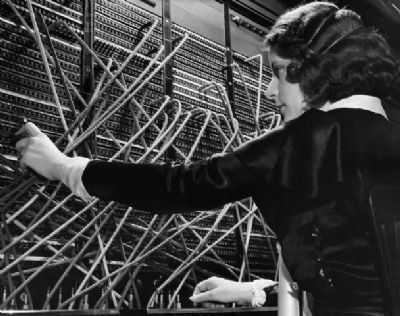
5. Telephone Operator at Work
Unused cords retract into the switchboard desktop with their plugs standing up at the ready at the bottom of the photograph, in pairs, front and rear. The operator grabs the rear plug and pulls up the cord to connect it and speak to the calling party. To complete the call, she pulls up the front plug and plugs it into the destination jack.
If when testing for busy she heard nothing, she pushed the plug all the way in to the jack, completing the connection. She then pushed the talk switch for the cord towards her. This disconnected her headset from your line and connected the ringing current to the other line, causing the bell of the called telephone to start ringing. She was then free to use another cord to answer another call, while you waited for the other party to pick up the ringing telephone. You would not hear the ringing noise. just silence until the other party picked up. Lamps next to each cord told her the status of each end of the line so if there was no answer she would see that, push the talk switch on your cord and tell you “that number does not answer” and wait for your response.
Your voice and the other party’s voice traveled across the cord the operator plugged between your jack and the other number’s jack for as long as you wished. When you hung up, the lamp for the cord you were using lit up and that was her signal to pull both ends of the cord from the jacks to end the call. The cord was now free to be used on another call.
The cords were weighted and retracted into the desk surface switchboard when not in use. Just the two plugs showed, ready to be grabbed when needed. The operator only had so many cords available to her. When she ran out of cords, she could not complete any more calls. The phone company added operator positions as more telephones were installed to make sure that sufficient cords and operators were available for normal traffic volumes. But during community emergencies the telephone exchange ran out of cords. Operators used their last cord to connect to callers to let them know no lines were available to complete their calls.
For efficiency, telephone operators were trained to speak mechanically, using only a handful of company-approved short phrases like “number please” and “that line is busy” and “thank you.” Unlike what you’ve seen in old movies, they could not converse or otherwise interact with you, on pain of being fired. Their job was to quickly connect your call and move on to connect the next one. And they were required to be pleasant and to continually thank you, even if you were rude or worse. It was not a glamorous job.
After operators stopped connecting local calls with the advent of local dialed calls, it was still many decades before long distance calls (calls to distant towns, cities and other countries) could be dialed. Long distance calls continued to be connected by hand, and they required two or more operators. Calls between two small towns required at least four operators and their cords. First was your local operator, who plugged you to a trunk to the nearest large city; the large city operator, who plugged you though to the distant large city; that city’s operator who plugged you though to the distant town’s operator; and the distant town operator, who dialed the local number for you. You told your local operator the town name and number and then waited. She relayed the information to each subsequent operator until the call was ready. There was no guarantee that your call would go through right away. More likely than not the operator would tell you that she would call you back when trunk lines to the distance city became available.
Occasionally you could stay on the line listening to the sequence of instructions relayed by voice by your long distance operator and the different voices identifying their city and responding to her. Most likely her first call would be to the Routes operator, who would look up and tell her what cities to use to reach the town you wanted. Then, one city or town at a time, she would thread your call onward until she got to that distant town. When she had the distant party on the line she would say to you “go ahead please,” and punch the billing ticket she had written up by hand (to record the time). Multiple operators could take many minutes to set up your call. No wonder the charge, which varied by mileage, was about $2.50 for a typical three minute call (almost $25 in today's money).
— Submitted March 1, 2015, by J. J. Prats of Powell, Ohio.
2. “I Am the Telephone”
by T. Harry Thompson in the December, 1935 edition of The C. and P. Call
“I am the telephone, friend of rich and poor alike. My body is brass and my heart, gold. My arms reach around the world and enfold it in my bosom. Through them courses electricity, my life-fluid. I speak all languages.
“Mine is the voice of commerce and romance. I transact business for the millions and convey the love notes of the world. I announce glad tidings of weddings, births, graduations, promotions. It is my equal duty to echo when a sob vibrates into the night. I am the voice of man . . . amplified, magnified, ramified.
“Routine is not beneath my dignity. I will order a limousine and a bag of salt in the same breath. I will send for a doctor, or summon a priest. I will make hazardous the work of the prowler, and peaceful the slumber for all. A word from me, and the community’s firemen leap into action.
“I am the telephone, companion of the many. I am a friend to the lonely, to the shut-in. I send the traveler on h is way with the assurance that I shall keep watch in his absence; that I shall notify him in an emergency; that I shall take to him the voices of his loved ones (and his to them), though sea and mountain separate them.
“My credo is service . . . you have but to ask. I am the telephone!”
— Submitted April 8, 2017.
Credits. This page was last revised on April 8, 2017. It was originally submitted on November 14, 2011, by Sandra Hughes Tidwell of Killen, Alabama, USA. This page has been viewed 922 times since then and 43 times this year. Photos: 1, 2, 3, 4. submitted on November 14, 2011, by Sandra Hughes Tidwell of Killen, Alabama, USA. 5. submitted on March 1, 2015. • Bernard Fisher was the editor who published this page.
